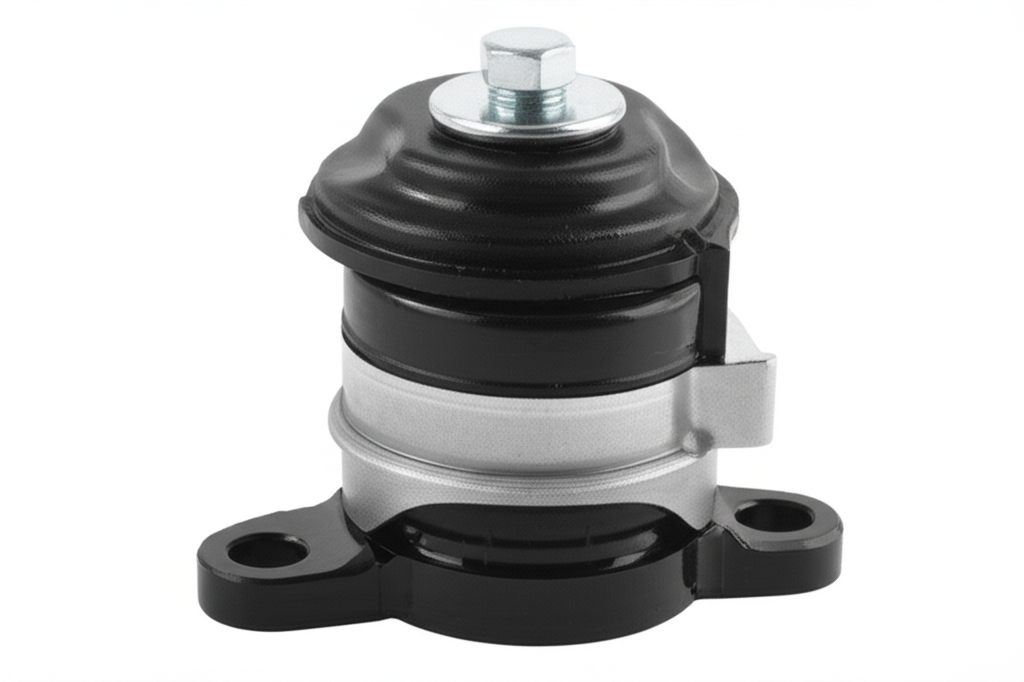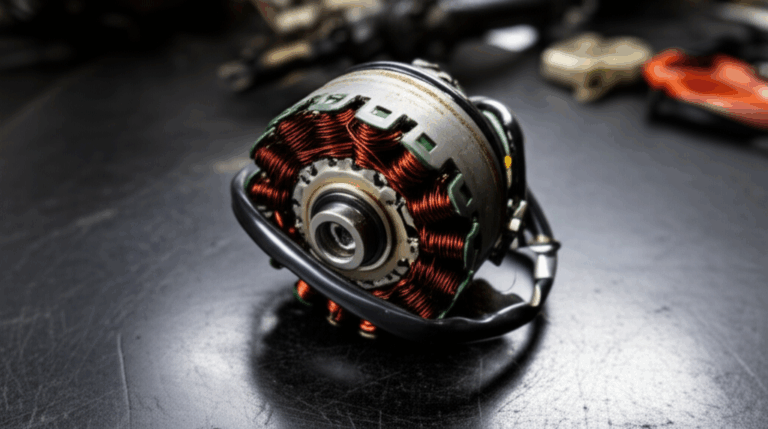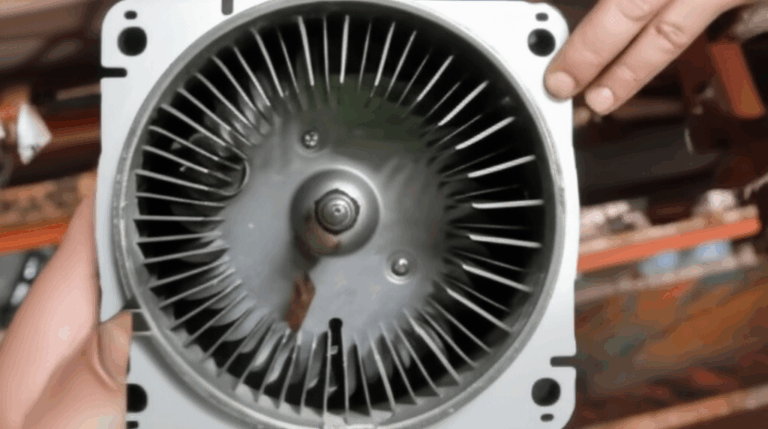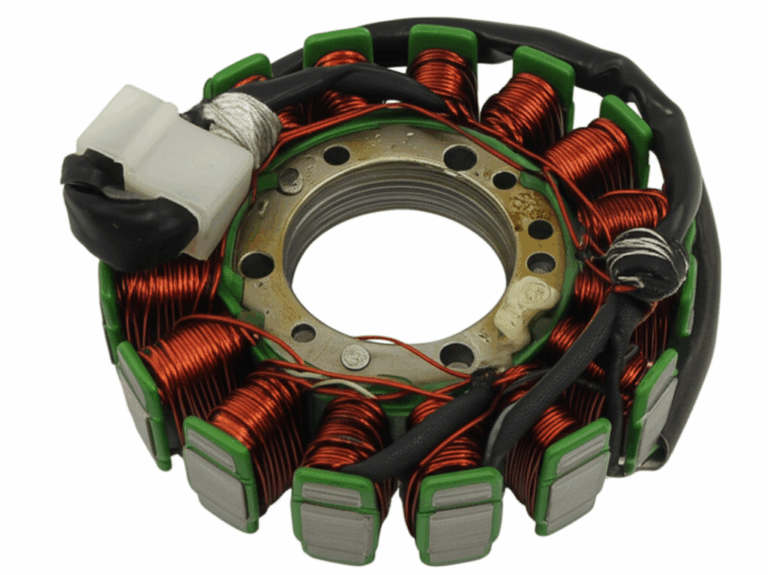
What Does a Motor Mount Do? Essential Guide to Engine Mount Function, Symptoms & Replacement
- Table of Contents
- What Does a Motor Mount Do?
- Why This Guide Is Worth Your Time
- What Is a Motor Mount?
- How Do Motor Mounts Support the Engine and Transmission?
- How Do Motor Mounts Cut Vibration and Noise?
- What Is Engine Torque and Why Does It Twist the Engine?
- What Types of Motor Mounts Do Cars Use?
- Where Are Motor Mounts Located?
- What Are the Signs of a Bad Motor Mount?
- What Causes Motor Mounts to Fail?
- Can I Check Motor Mounts Myself or Should I See a Mechanic?
- How Much Does Motor Mount Replacement Cost?
- Will New Motor Mounts Improve Driving Feel and Safety?
- Do Electric Cars Need Good NVH Control Too?
- Real-World Example and Inspection Checklist
- FAQs
- Data Table: Lifespan, Cost, and NVH Impact
- References
- Key Takeaways
Motor mounts may look small. Yet they carry big jobs. They hold the engine and transmission in place. They cut shakes and noise. They help keep your ride safe and smooth. I wrote this guide so you can spot problems fast. You will learn the motor mount purpose, the engine mount function, how to check them, and how to fix issues before they get worse.
Why This Guide Is Worth Your Time
Here is the Problem. Your car shakes at idle. You hear a clunk when you shift. The dash buzzes. You worry that something is wrong.
Let’s Agitate it a bit. That shake can grow. The exhaust can crack. Hoses can tear. CV joints and bearings can wear out fast. The fix can cost more later.
Now the Solution. Learn what motor mounts do. Spot bad motor mount symptoms early. Choose the right parts. Decide on DIY motor mount replacement or mechanic motor mount repair. Save time and money. Gain a quiet, steady ride.
What Is a Motor Mount?
A motor mount is a part that connects the engine and transmission to the vehicle chassis or subframe. It uses metal and rubber. Some use fluid or even vacuum control. The job is simple. It must secure the engine, absorb vibration, and dampen noise. It also holds things in line so the powertrain stays true.
Think of a mount like a thick shoe sole for your engine. It keeps the engine from pounding the frame. It stops metal-on-metal contact. It adds vibration isolation so your hands and seat do not buzz.
How Do Motor Mounts Support the Engine and Transmission?
Motor mounts carry the engine and transmission. They tie the heavy parts to the engine cradle, crossmember, or subframe. They keep drivetrain components aligned. They guard the exhaust system, CV joints, and axle from stress.
Good mounts limit excessive engine movement. They stop engine rocking during starts and stops. They help engine alignment so parts like the gear shifter move cleanly. This boosts power train stability and transmission stability. When the engine and trans stay put, the car feels sure on the road.
How Do Motor Mounts Cut Vibration and Noise?
Engines shake by nature. They shake at idling, during acceleration, and during braking. The mount’s rubber or fluid soaks up those shakes. This is Noise, Vibration, and Harshness (NVH) control. Good NVH makes the cabin calm. You feel better steering feel. Passenger comfort goes up. The dash and dashboard stay quiet.
Rubber or fluid adds a cushion. This cushion blocks dynamic forces from the engine bay. It handles static forces from the weight of the engine. That is how mounts dampen noise. That is how they prevent engine damage and protect the suspension system as well.
What Is Engine Torque and Why Does It Twist the Engine?
Engines make torque. Torque acts like a twist. When you hit the gas you feel engine torque push the car. The engine wants to twist the other way. This is torque reaction. Without firm mounts the engine can lift and slam. You hear a knocking sound. You feel a clunking noise when accelerating. You might see the engine jump.
Mounts resist that twist. They help the engine send power to the wheels with less waste. This keeps vehicle performance sharp. It also helps vehicle handling and keeps the steering wheel calm.
What Types of Motor Mounts Do Cars Use?
You will see several types:
- Rubber motor mounts: Most common. Good vibration isolation. Low cost.
- Hydraulic motor mounts (fluid-filled): Better at soaking engine vibration. Smooth at idle.
- Vacuum-controlled mounts or active motor mounts: Use valves or control to change damping. They can calm idle shake and stiffen during a hard pull.
- Polyurethane motor mounts: Stiffer. Good for performance motor mounts. More feel. More cabin buzz.
- Solid motor mounts: Metal to metal. Used in racing. Max control. Max vibration.
Each type tunes the stiffness of mounts. Soft mounts feel comfy. Stiff mounts lock the engine down. The right choice depends on your goals.
Where Are Motor Mounts Located?
Most cars have three or four mounts. Common spots include:
- Front motor mount
- Rear motor mount
- Side motor mount
- Torque strut mount
- A transmission mount near the transmission housing
Setups vary by car. Front Wheel Drive (FWD) uses a different layout than Rear Wheel Drive (RWD). All Wheel Drive (AWD) can add more brackets. The mounts tie to the vehicle chassis, subframe, or engine cradle with bolts, nuts, and a mounting bracket.
What Are the Signs of a Bad Motor Mount?
Watch for these common motor mount issues:
- Increased engine vibration: You feel it in the seat, floor, and steering wheel. It may be worse at idle or at a set RPM. You might feel a car shaking when idling.
- Loud clunking or banging noises: On accelerate hard, on braking, on a shift, or over bumps.
- Excessive engine movement: The engine lifts or rocks. The dashboard or gear shifter moves.
- Rough idling and new drive train noise. New buzz in the engine compartment.
- Uneven engine wear or misalignment: Hoses stretch. Wiring harnesses rub.
Some of these can be transmission mount symptoms too. A bad transmission mount can feel like a bad engine mount. They do a similar function in a different spot.
What Causes Motor Mounts to Fail?
Mounts fail for many reasons:
- Normal wear and tear: Aged rubber mounts crack from heat and time. This is the top cause.
- Exposure to fluids: Oil leaks or coolant will soften rubber. Oil leaks damaging mounts is common.
- Driving habits: Heavy acceleration wear and hard braking stress the mount. Rough roads impact can also crush the rubber.
- Accident impact on mounts: A hit can bend a bracket.
- Manufacturing defects: Rare, yet possible. Watch for recalls.
In short, mounts are not lifetime parts. They wear. So plan for it.
Can I Check Motor Mounts Myself or Should I See a Mechanic?
You can do a quick motor mount inspection at home. Use this simple inspection checklist:
- Look for cracks in rubber.
- Check for torn or leaking fluid-filled mounts.
- Watch the engine as a helper shifts from Park to Drive with the brake pressed. Look for engine movement during shifting.
- Listen for knocking sound or a thud as the engine loads.
- Look for shiny metal where metal-on-metal contact may occur.
Use common diagnostic tools like a good flashlight and a mirror. A pry bar can show free play. Still I suggest a mechanic if access is tight. Some mounts hide under the crossmember. Some need the engine lifted. Safety matters.
How Much Does Motor Mount Replacement Cost?
Here is what to expect. Cost varies by car, region, and setup.
- Parts:
- Standard rubber: about $50 to $200 per mount.
- Hydraulic or active: about $100 to $400+ per mount.
- OEM motor mounts cost more than aftermarket motor mounts. Fit and NVH often match the factory when you buy OEM.
- Labor:
- About $100 to $400 per mount. Typical repair time is 1 to 3 hours per mount.
- Some cars need more time. Think FWD with tight bays or AWD with more parts in the way.
Plan for cost of parts vs labor. On some jobs labor beats parts. Ask about warranty on parts and labor. Check for recalls on your model.
Will New Motor Mounts Improve Driving Feel and Safety?
Yes. The benefits of replacing motor mounts show up fast:
- Improved driving experience
- Reduced noise inside car
- Better engine stability and transmission stability
- Preventing further damage to the exhaust system, CV joints, axles, driveshafts, hoses, and wires
- Restored power train stability and steering feel
- Better vehicle performance and safety implications in hard stops or turns
Fresh mounts can make an old car feel tight again. Your cabin grows quiet. Your hands relax on the wheel.
Do Electric Cars Need Good NVH Control Too?
They do. EVs have motors with stator and rotor parts. The mounts still matter because the drivetrain still loads the body. EVs also rely on the quality of motor core laminations for smooth NVH.
If you work on EV motors consider the role of high-grade electrical steel laminations. They reduce buzz at source. They also boost efficiency by cutting eddy losses. For example, the right stator core lamination and the matching rotor core lamination can help the motor run quiet at idle and at load. The full stack of motor core laminations also shapes tone and hum. When you choose precise laminations you raise NVH quality before it ever reaches the mounts. Learn more about modern electrical steel laminations used in BLDC and AC motors.
Good mounts and good motor design work as a team. They calm NVH. They raise passenger comfort. They boost the feel of quality.
Real-World Example and Inspection Checklist
A customer drove in with a Honda Civic. The car had a rough idling shake. The dashboard buzzed. I felt a clunk on a hard start. We found a torn front mount. The rubber split due to oil leaks from a valve cover. We fixed the leak and replaced the mount. The car went quiet.
Next week a Ford F-150 came in. The owner towed a boat. He felt a clunking noise when accelerating. The engine lifted under load. The rear motor mount and torque strut mount were shot. Heavy use and rough roads impact did the harm. New mounts restored engine stability.
Then a Toyota Camry owner came in with a hum. It was a transmission mount this time. The symptoms of bad transmission mount can mimic a bad engine mount. We confirmed with a lift and replaced it.
Use this simple checklist when you suspect worn motor mount issues:
- Look for sag or cracks on each mount. Check front motor mount, rear motor mount, and side motor mount.
- Watch for the engine to tilt in gear.
- Check that the subframe and engine cradle bolts are tight.
- Look for leaks near hydraulic motor mounts.
- Verify OEM parts match your vehicle type specific mounts for FWD, RWD, or AWD.
Keep a short note in your own “car repair glossary”. When you hear a new noise write it down. This helps you describe the issue to your automotive repair shop.
FAQs
- Can I drive with a bad motor mount?
- You can in a pinch. I do not advise it though. You risk damage to drivetrain components, the exhaust system, and even transmission components. Safety can suffer.
- How long do motor mounts last?
- Many last 5 to 7 years or 50,000 to 100,000 miles. Heat, leaks, and roads can shorten that.
- Is a transmission mount the same as a motor mount?
- The job is similar. The spot is different. Both support and both cut vibration.
- Are aftermarket parts OK?
- Some are fine. Quality varies. Many cars ship with fluid-filled mounts. If you swap to a solid rubber mount you may change NVH. Choose with care.
- Do performance motor mounts help?
- They can. Polyurethane motor mounts and solid motor mounts hold the engine tight. You may feel more shake though.
Data Table: Lifespan, Cost, and NVH Impact
| Item | Typical Range | Notes |
|---|---|---|
| Typical lifespan | 5–7 years or 50,000–100,000 miles | Varies by vehicle age, road conditions, and mount type |
| Parts cost | Rubber/Standard: $50–$200 per mount | OEM parts fit and NVH often match factory spec |
| Parts cost (Hydraulic/Active) | $100–$400+ per mount | Higher on luxury cars with active motor mounts |
| Labor cost | $100–$400 per mount | 1–3 hours per mount on average |
| NVH reduction when healthy | Often 80–95% less vibration felt in cabin | Based on industry practice and OEM targets |
| Risk if ignored | Damage to CV joints, axles, driveshafts, exhaust system hangers, and hoses | Secondary damage can cost 2–5x the mount repair |
Numbers are estimates. Each specific vehicle make and specific vehicle model can differ.
What Should I Choose: OEM or Aftermarket?
You face a choice. OEM motor mounts tend to match factory feel. Fit is exact. NVH is predictable. Some aftermarket motor mounts are great. Some are too stiff. Some replace a hydraulic design with a solid rubber block. That can raise cabin noise.
Ask your mechanic. Share your goals. Do you want a quiet ride or more feel. Do you tow. Do you track the car. Pick the mount that fits your use.
Can I Replace Motor Mounts Myself?
Some jobs are easy. Some are not. You may need to lift the engine with a jack and wood block. You must support the oil pan with care. You must line up the mounting bracket to the subframe or engine cradle. You will use bolts and nuts torqued to spec.
If space is tight I go to an automotive repair shop. They have lifts and the right tools. They will also check warranty and confirm there are no recalls on your car.
How Do Mounts Affect Handling and Comfort?
Mounts change how the car feels. Softer mounts cut noise and vibration. They help passenger comfort. Stiffer mounts lock the engine. They help throttle response. They can change steering feel. They can add harshness at idle.
Pick the feel you want. Family car. Daily driver. Work truck. Track toy. Your choice sets the stiffness of mounts you need.
Will Bad Mounts Hurt Other Parts?
Yes. This is why you act fast.
- Exhaust system can crack from extra motion.
- Hoses and wiring harnesses can stretch or rub through.
- CV joints and bearings can wear due to new angles.
- Transmission components can take shock loads.
- Drivetrain components can vibrate and loosen.
Fixing mounts is preventative maintenance. It can save you from bigger bills.
EV and Hybrid Note: Laminations and NVH
If you work with BLDC motors or hybrids you will care about the motor core. The stack of thin steel sheets reduces loss and sound. This is where anti-vibration technology in design starts. Good lamination geometry can target hum at idle and high load. The mount then finishes the job. Together they shape the car’s NVH.
- High precision lamination stacks improve smoothness at source.
- Better core material reduces hiss and whine.
- Good stack bonding cuts buzz.
This design work pairs with the right mounts. The result feels refined.
References
- OEM service manuals for engine and transmission mount service procedures
- SAE International texts on NVH fundamentals and vibration isolation in vehicles
- Independent shop experience with Honda Civic, Ford F-150, and Toyota Camry mount repairs
- Manufacturer parts catalogs for OEM parts and aftermarket parts options
Wrap-Up: Bullet Summary
- Motor mounts secure the engine and transmission to the vehicle chassis and subframe.
- They absorb vibration, dampen noise, and manage engine torque.
- Watch for car shaking when idling, clunking noise when accelerating, and excessive engine movement.
- Aged rubber mounts, oil leaks, hard use, and hits cause failure.
- Replace worn mounts to protect drivetrain components, the exhaust system, hoses, and wires.
- Choose between OEM motor mounts and aftermarket motor mounts based on NVH and cost.
- Hydraulic motor mounts, vacuum-controlled mounts, and active motor mounts offer smooth rides.
- Plan for cost of parts vs labor. Expect 1–3 hours of labor per mount.
- FWD, RWD, and AWD layouts change mount locations and time.
- EVs also need good NVH. Quality motor core laminations and mounts work together for a quiet car.
Short FAQs
- What are engine mounts?
- They are supports that hold and isolate the engine and transmission.
- How to check motor mounts?
- Look for cracks and leaks. Watch the engine move in gear.
- When to replace motor mounts?
- When you see tears, leaks, big movement, or new noise.
- What is a transmission mount?
- A mount for the transmission. It supports and isolates like an engine mount.
- Difference between engine and transmission mount?
- Location and load differ. Function is similar.
Notes on Entities and Practical Tips
- Keep an eye on engine performance if you feel new shake.
- Check road conditions on your commute. Rough roads speed wear.
- Park over clean cardboard to catch oil leaks before they ruin mounts.
- Ask your shop about diagnostic tools they use for NVH checks.
- Ask about warranty terms on labor and parts.
- Use an inspection checklist at each oil change. Look at mounts, hoses, and belts.
- Mind vehicle type specific mounts for your model. Honda, Ford, and Toyota have special designs for the Civic, F-150, and Camry.
By the way, if you work with EV motors or you build projects at home, study how lamination stacks shape NVH. Precision in the stator core lamination and the rotor core lamination will help a lot. Full-stack design of motor core laminations plus proper mounts leads to smooth power. Learn more about modern electrical steel laminations as you plan your build.








